|
|
 |
|
|  |
| |
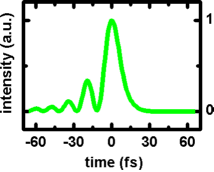
What is the exact shape of a femtosecond pulse?
A general aspect of ultrashort pulse generation is the need for a careful management of higher order chirp. Pulses like the ones dispayed to the left are typical when only the first order of chirp is controlled with a grating or prism compressor. Techniques to counteract the higher-order chirp and the satellite pulses are available, but they require a detailed knowledge about the full spectral phase of the pulses. A ZAP-SPIDER measurement provides that information, and together with a characterization of the CE-phase we obtain an almost complete knowledge about the optical light field.
|
Full pulse characterization directly at the experimental interaction point
The novel ZAP-SPIDER technique allows to fully characterize the temporal shape and phase of ultrashort optical pulses directly at the interaction point of a spectroscopic experiment. The scheme is suitable for an extremely wide wavelength region from the ultraviolet to the near infrared and can measure the shape of the shortest light pulses available today. |
|
The principle of ZAP-SPIDER
The unknown pulse is directly guided into a nonlinear crystal and overlaps with two strongly chirped auxiliary pulses coming from different directions. The auxiliary pulses provide two approximately monochromatic sum or difference frequency mixing interactions with the short unknown pulse. Sum frequency generation is used for the analysis of visible pulses, difference frequency generation for UV pulses. Due to the delay between the auxiliary pulses the unknown pulse is mixed with two different frequency components and two spectrally sheared replicas are generated. They are recombined with a delay and interfere in a spectrograph. The resulting interferogram encodes the phase differences between pairs of sheared frequencies in the fringe spacing. The complete shape and phase of the unknown pulse is unambiguously reconstructed by a direct Fourier transform and filtering technique.
|
|
|
phase mask in the Fourier plane
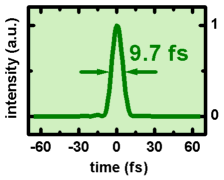
|
Spectrum: "all of the UV"
achromatic phase matching
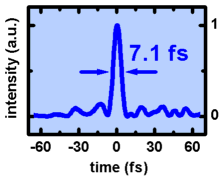
|
chirped frequency doubling
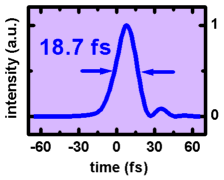
|
|
deformable mirror
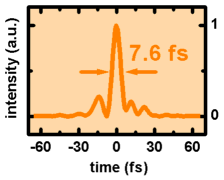
|
Having well-characterized pulses is essential for:
-
-
-
-
understanding the chirp transfer in nonlinear interactions
-
electronic dephasing experiments with the highest time resolution
-
generation of shaped UV pulses
-
knowing the envelope in a CE-phase experiment
-
...
|
|
|
|  |
"Design and calibration of zero-additional-phase SPIDER"
P. Baum and E. Riedle
J. Opt. Soc. B 22, 1875 - 1883 (2005)
Details
"Full characterization of ultraviolet and visible 10-fs pulses with zero-additional-phase SPIDER"
P. Baum, S. Lochbrunner, and E. Riedle
Ultrafast Phenomena XIV, T. Kobayashi, T. Okada, T. Kobayashi, K. Nelson, S. De Silvestri, eds. (Springer-Verlag, Berlin, 2005), 130 - 132
Details
"Zero-additional-phase SPIDER:
full characterization of visible and sub-20 fs ultraviolet pulses"
P. Baum, S. Lochbrunner, and E. Riedle
Opt. Lett. 29, 210 - 212 (2004)
Details
"Real-time characterization and optimal phase control of tunable visible pulses with
a flexible compressor"
P. Baum, S. Lochbrunner, L. Gallmann, G. Steinmeyer, U. Keller, E. Riedle
Appl. Phys. B 74 [Suppl.], S219 - S224 (2002)
Details
| | |

